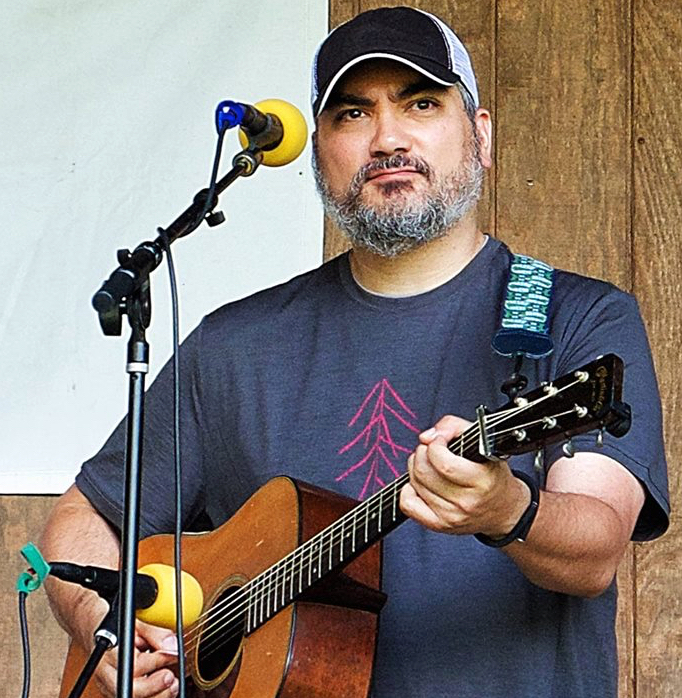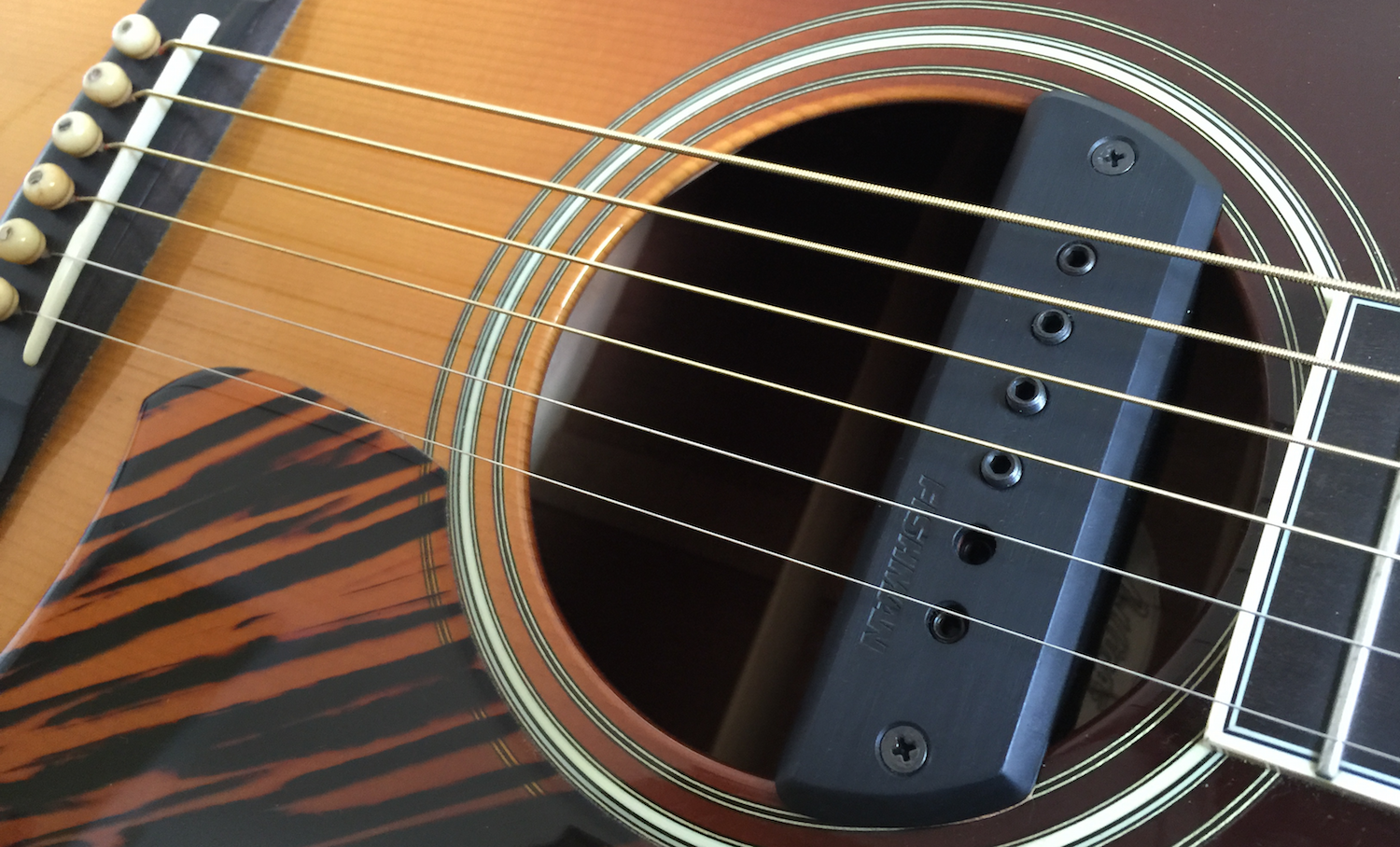Plugging in with Fishman
 How I usually feel about the way sound guys mic my guitar.I haven't touched an electric guitar in years, but recently have become interested in learning about acoustic amplification. The goals are to be able to:
How I usually feel about the way sound guys mic my guitar.I haven't touched an electric guitar in years, but recently have become interested in learning about acoustic amplification. The goals are to be able to:
1) ...plug in when getting on stage for impromtu sets at bluegrass festivals. I'm tired of having to rely on sound guys dialing-in the instrument microphones. They never seem to get the signal hot enough (which is understandable, given the issues with feedback and that they don't have much time to get things set up between sets).
2) ...have a second channel/option when I'm playing out with our band(s). Typically I've used an instrument microphone (Shure SM81) which has worked fine, but having an additional option for more volume while reducing feedback would be nice.
3) ...mess around with this stuff at home, both to (a) get to know the equipment and dial the sound in before heading out to play live, but also to (b) reinforce the sound a bit at jams. So in addition to getting a guitar pickup, I'll need a small acoustic amp.
After spending way too much time researching online, here's what I ended up getting:
Pickup
I decided the best option was a soundhole pickup so I could potentially swap it between several guitars without too much fuss, and ended up selecting a Fishman Blackstack magnetic pickup ($250). These are supposedly a modern take on the classic Sunrise pickup that some of my favorite artists play (e.g., Lyle Lovett, Richard Thompson), and what I like about the Blackstack is that it can be disconnected from its cable and moved between guitars for different mounting strategies with minimal fuss. The Blackstack comes with a 10' cable that can be run out of the soundhole and connected to a standard guitar cable for a "temporary" installation. But Fishman also sells a 22" cable and endpin jack for a more permanent installation ($40). I installed this shorter cable/jack in my Collings CJ, which previously had a pickup so the endpin was already drilled for a jack. When I want to plug in a different guitar, I'll disconnect the Blackstack from the cable in the CJ (which takes a couple of minutes with nimble fingers and a small screwdriver), connect it to 10' cable, and temporarily mount it in another guitar.
Note: I also considered the Baggs M1, M1A, and M80, and Schertler Magnetico AG6, which are similarly swappable between guitars, but ultimately chose the Blackstack due to its similarity to the classic Sunrise pickup. To be fair, the Sunrise system can also be set up to be swappable, but I likely would have needed a guitar tech to do the wiring. With the Blackstack I was able to do it myself in less than 15 minutes.

Preamp
Since the Blackstack is a passive pickup and doesn't have any controls, a preamp is a good idea, and I ended up choosing the Fishman Platinum Pro EQ. Along with the standard EQ and tone shaping functions, it has a boost footswitch, tuner, and a compressor. The boost footswitch is especially nice for punching in a solo. In addition to going into an amp when at home, this will be used with a PA system when playing out. Street price is usually $250, but I was able to find one new for under $215.
Note: The Baggs Venue has similar features, sans the compressor, but was $50 more. In addition to getting the Platinum Pro EQ, I also bought the smaller Fishman Platinum Stage preamp to throw in my guitar case when heading out to a festival in case we end up playing on stage. This is a total luxury and I'm not counting it in the total cost of the system.

Acoustic amplifier
The first decision was whether to get a small PA system and mixer, or an "all-in-one" acoustic amp. I wasn't as concerned with overall volume/power of the system, but what was important was getting the right number of inputs. At a minimum, I want to be able to have three things plugged in simultaneously: a vocal microphone (Shure SM58), an instrument microphone (Shure SM57 or SM81), and a guitar plugged in via the preamp. Getting a mixer would solve this and allow for a flexible number of inputs going into a PA system, but this solution seemed to be overkill given that two of the guys I play with have PAs, and I'm looking more for home use. The Bose L1 Model II with the ToneMatch mixer looks awesome, but I'm not ready to make that leap yet. So it was on to acoustic amps...
It turns out that finding an acoustic amp with three separate channels (with two of those being XLR) is not easy. The AER Compact 60 that everyone raves about looks awesome, and going into my research I assumed that this would be what I ended up getting, but it only has two channels (one XLR and one 1/4"). This seems to be the norm for acoustic amps of this size, since they are aimed at singer-songwriters who are need inputs for only vocals and one guitar. This makes total sense; my needs here are admittedly somewhat unusual.
Ultimately the choice boiled down to offerings from three companies: AER, Schertler, and Fishman. While AER's Compact 60 is one channel short for me, their Domino 2 has exactly what I'm looking for. But it's around $1800, and that's just not in the cards at this point. Schertler's Jam series (100/150/400) would fit the bill here, as would their Unico, as they all have at least three channels with two of those including XLR inputs. The Unico is still more money than I wanted to spend at this point ($1100), and like the Unico, the Jam 150 and 400 have more power than I need. But the Jam 100 hits all of the criteria on my list at a price I could swallow ($800, although I did find one place selling it new for $600).
 Fishman's three Loudbox acoustic amps all have two dedicated input channels for instruments. The Mini has one 1/4" and one 1/4"+XLR combo; the Artist and Performer have two identical 1/4"+XLR combo channels. The kicker is that all of the Loudbox amps have an AUX input as well. So with the Artist or Performer, two microphones could go into the two main channels, and then the guitar can go into the AUX input via the preamp. The Loudbox Artist has a street price of around $550, but I was able to find it new for $495, including shipping. Compared to the options from AER and Schertler, this is the most affordable way to get the three inputs I need.
Fishman's three Loudbox acoustic amps all have two dedicated input channels for instruments. The Mini has one 1/4" and one 1/4"+XLR combo; the Artist and Performer have two identical 1/4"+XLR combo channels. The kicker is that all of the Loudbox amps have an AUX input as well. So with the Artist or Performer, two microphones could go into the two main channels, and then the guitar can go into the AUX input via the preamp. The Loudbox Artist has a street price of around $550, but I was able to find it new for $495, including shipping. Compared to the options from AER and Schertler, this is the most affordable way to get the three inputs I need.
Note: The Loudboxes also have some simple effects built in (reverb, chorus, delay, echo, flanger) along with some tools to fight feedback; the Jam 100 has reverb, but not other effects. I'm not sure how much I'll use these, but since it was more than $100 less expensive, has these additional effects, and has more output options, the Loudbox Artist just nosed out the Jam 100.

So that's how I ended up with an acoustic amplication system for my guitar that is entirely from Fishman. I don't have any particular attachment to the brand, and didn't go into this process expecting that any of the components in the signal chain would be from Fishman, but these ended up being the best options at this price point: Blackstack ($250), 22" installation cable for the Blackstack ($40), Platinum Pro EQ ($215), and Loudbox Artist ($495) = $1000 total.
 Wednesday, August 26, 2015 |
Wednesday, August 26, 2015 |  Post a Comment | tagged
Post a Comment | tagged  acoustic amp,
acoustic amp,  aer,
aer,  baggs,
baggs,  blackstack,
blackstack,  fishman,
fishman,  guitar,
guitar,  loudbox,
loudbox,  pickup,
pickup,  platinum pro eq,
platinum pro eq,  preamp,
preamp,  schertler,
schertler,  sound reinforcement
sound reinforcement 
Reader Comments